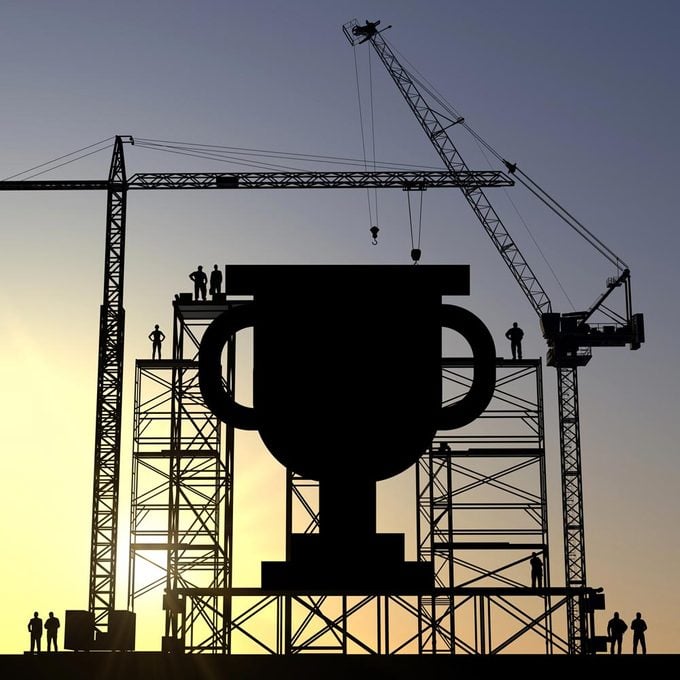New Survey: This Is the No. 1 Happiest Job in the World
Updated: Nov. 23, 2023

Rising wages, job security, a sense of purpose and work-life balance—the happiest job has it all!
To many people, happiness at work sounds like a fantasy. They toil away for hours on end, often for too little pay and limited room for advancement. Work-life balance? Never heard of it. Career goals? To make it to Friday.
But not everyone spends the workday thoroughly unhappy, dreaming of quitting their day job and finding one of those so-called lazy-girl careers. Some are truly happy even when they’re on the clock. So which sector promises to turn that workplace frown upside down? That’s exactly what BambooHR set out to learn in its recent report.
The company did a deep dive into what it calls The Great Gloom and found that certain industries have happier employees than others. One, in particular, stands out as the happiest job of all. So if you’ve found yourself at a career crossroads, miserable at work and ready to make a move, keep reading to learn which job promises the greatest happiness.
Get Reader’s Digest’s Read Up newsletter for more career advice, humor, cleaning, travel, tech and fun facts all week long.
How did the survey determine the happiest job?
To analyze happiness on the job, BambooHR gathered data between January 2020 and June 2023 from over 57,000 employees at more than 1,600 companies. They represented a range of industries: health care, finance, construction, education, travel and hospitality, food and beverage, and technology.
The company’s findings also included more than 1.4 billion self-reported employer net promoter scores, a survey-based measurement of how satisfied and loyal an employee is. BambooHR considered factors such as wage, flexibility, opportunities for development, mission and values to rank eight industries based on employer net promoter score for the first half of 2023.
What industry reports the highest job satisfaction?

BambooHR’s survey found construction to be the happiest industry. Yes, it’s hard, back-breaking work. No, there isn’t much job flexibility, a major marker of happiness. And no, there isn’t an opportunity for remote work with this hands-on job. But that’s only part of the picture.
Laura Putnam, a workplace well-being consultant and the author of Workplace Wellness That Works, points out that factors such as camaraderie among co-workers and time spent outside contribute to the high level of happiness in this job.
Those are just two of the many characteristics of construction that make its employees happier than their peers. Read on for several aspects affecting worker happiness in this field.
Rising wages
The Associated General Contractors of America, an organization representing the construction industry, reports that between May 2021 and May 2022, hourly construction wages rose 6.3%, the greatest growth since 1982.
Higher paychecks? That’s a recipe for happier employees.
Job security
Not only is the pay good and getting better, but unemployment is low in the industry, and skilled workers are in high demand thanks to robust construction spending. The U.S. Census Bureau reports that spending has been on a steady incline since 2020, and construction spending was up 4.2% for the first eight months of 2023 compared with the same period in 2022.
Time outside
Some construction jobs take place indoors, but the majority occur outside. That’s a reason this is one of the best careers for your health. “Time outside is critical for our health and well-being,” Putnam says. “Getting out into nature is important, but so is just being out in the world interacting.”
Combine that outdoor time with the physicality of construction work, and you have even more reason to smile. “The research shows that staying physically fit is associated with higher levels of happiness—especially when that exercise is done outside—which is one explanation for why construction crews are happy,” explains Scott Shigeoka, an internationally recognized curiosity expert and the author of Seek: How Curiosity Can Transform Your Life and Change the World.
Face-to-face interaction
Spending your day alone in a cubicle staring at a screen is depressing by most people’s standards. Working from home can be equally isolating, especially if you don’t use the remote-work perk—and the hours of commuting it saves you—to spend more time socializing in your free time. But construction workers don’t have to worry about that.
These manual laborers usually work together on tasks and often share jokes and stories on the job. Plus, there’s a built-in level of trust when working around heavy machinery. “Having a best friend at work is one of the highest predictors of levels of engagement,” Putnam says. “And those who have not just a good friend but a best friend at work are seven times more likely to be highly engaged in their work.”
Shigeoka says that construction workers’ “social fitness” is even more powerful and interesting than their physical fitness when it comes to achieving high levels of happiness. “From the treasure trove of research that exists on this topic, we know that the ultimate key to our happiness in our work and life is to forge deep and positive relationships with others,” he says.
A sense of purpose
In addition to building relationships with one another, construction workers are building and creating tangible structures. As it turns out, this significantly contributes to their overall job happiness. Instead of competing, workers are truly cooperating to create something, and in the process, they feel a sense of purpose.
“Most organizations are stuck in fear-based leadership, which creates toxic work experiences,” say Chris Deaver and Ian Clawson, co-authors of Brave Together. “Co-creative cultures create brave space for deep, magical connections to happen where leaders inspire sharing [and] deep empathy and people are powered by principles to shape the future together.”
Work-life balance
Although construction work is physical and, at times, exhausting, you can’t bring it home with you. Work stays at work, and employees get to enjoy their time off with friends and family. Although most of us strive for work-life balance, it can be hard to set strict boundaries. Logging off completely seems unattainable, especially since there are always more emails to answer. Let these work-life balance quotes inspire healthier boundaries between your work and personal life.
What other jobs round out the top five?

Technology came in second in the BambooHR survey, but it may be a short-lived runner-up. With return-to-office mandates and financial volatility, happiness is declining at a rate of 145% in 2023 compared to 2022.
In the third-place slot, finance holds steady despite a decline in happiness over the past three years. According to the survey, “finance workers are more engaged, and they’re generally positive about decision-making, well-being and leadership at their organizations.”
Nonprofits, restaurants and other food and beverage companies, and the travel and hospitality industry followed, all with an employer net promoter score of 35 (compared to construction’s score of 49).
Which industries are the least happy?
Of the eight industries examined by BambooHR, the health-care sector wins for the least happy. That’s no huge surprise: Health-care workers have been increasingly unhappy since 2020, when they were stretched beyond their limits dealing with the COVID-19 pandemic. According to the report, worker trauma, dissatisfaction and burnout from the pandemic are serious issues.
Also not feeling the joy are teachers. Unhappiness is growing in the education field (though happiness spikes, predictably, during winter and summer vacations). Why are our educators so dissatisfied? Like health-care workers, they were overworked and overstressed during the pandemic. But they’re also underpaid. Political pressure about curriculums just adds to the issue.
Why are so many workers unhappy?
Workplace stress is at an all-time high, but if you have a job, you probably already know that. And yet when Gallup surveyed workers for a 2023 State of the Workplace report, the findings were staggering: 60% of people said they felt emotionally detached at work, and 19% reported being miserable. Despite the pandemic mindset shift toward increased work-life balance and more work-from-home flexibility, 50% of U.S. employees reported daily stress at work, and many said they felt worried, sad and angry when they’re on the clock.
Any way you slice it, people aren’t very happy on the job. A variety of factors lead to unhappiness at work, but most of them are precursors to work burnout—a lack of time and resources to meet your workload, for instance, or not feeling valued or appreciated.
You can burn out in any job, but the risk is higher in some professions, like education and health care. Neha Sangwan, MD, a corporate communication expert and the founder and CEO of Intuitive Intelligence, knows this firsthand. She spent a decade as an internal-medicine physician working 36-hour shifts, which brought her to burnout in her early 30s. Needless to say, she isn’t surprised to see health care at the bottom of the list.
“Burnout is a wake-up call that’s often rooted in a breach that began on a spiritual level,” Dr. Sangwan says. “Somewhere along the way, often for our survival, we made a series of what seemed like small choices, but it gradually led us to deviate from what we value most. Pretty soon, we’re so far away from home, we don’t even recognize ourselves.”
What does this look like? Saying “yes” when we should say “no” or prioritizing work over family … again. It might mean we agreed to another late night rather than a good night’s sleep or we chose to stay silent rather than speak up.
How can I find (or make) a happier workplace?
If you don’t work in construction, you may wonder if happiness is in the cards at your job. According to Talia Fox, CEO of KUSI Global and author of the forthcoming book The Power of Conscious Connection, taking a few small actions can help leaders increase happiness at work.
“The key to creating a successful, happy organization lies in conscious connection, which means being aware of the evolving needs of the workforce and having the ability to meet those needs,” Fox explains. In her book, she notes that leaders can use four simple actions—listen, observe, align with values and engage—to increase employee happiness. Searching for a job that will make you happier? Look for a boss with those skills.
About the experts
- Laura Putnam is a workplace well-being consultant and the CEO and founder of Motion Infusion, a workplace-wellness company. She is a frequent keynote speaker, has trained more than 15,000 managers and leaders across all industries, and is the author of Workplace Wellness That Works.
- Neha Sangwan, MD, is the CEO and founder of Intuitive Intelligence, an internal-medicine physician, an international speaker, a corporate communications expert and the author of Powered by Me. Her private practice and corporate consulting focus on empowering individuals, organizational leaders and their teams with the tools for clear, effective communication.
- Scott Shigeoka is an internationally recognized curiosity expert and the author of Seek: How Curiosity Can Transform Your Life and Change the World.
- Chris Deaver and Ian Clawson are the co-founders of the leadership and culture consultancy BraveCore. They’re also the authors of Brave Together.
- Talia Fox is the CEO of KUSI Global and the author of The Power of Conscious Connection. A Harvard University Fellow, Fox has a master’s degree in counseling psychology and is an inspirational leader who her clients refer to as the Jedi of Inspiration.
Sources:
- BambooHR: “The Great Gloom: In 2023, Employees Are Unhappier Than Ever. Why?”
- Associated General Contractors of America: “Construction Employment Climbs by 36,000 in May, While Hourly Earnings Rise at Fastest Yearly Rate in 40 Years as Firms Scramble to Fill Positions”
- U.S. Census Bureau: “Monthly Construction Spending, August 2023”
- Gallup: “State of the Global Workplace: 2023 Report”



